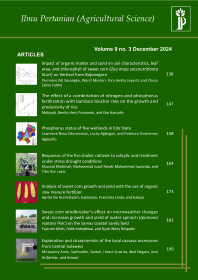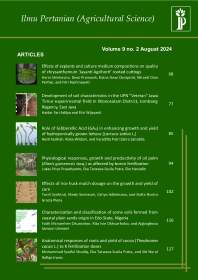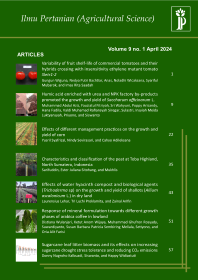The Effects of Filter Cake and Bagasse Ash to Growth and NPK Uptake by Sugarcane (Saccharum Officinarum L.) at Ultisols in Tulang Bawang, Lampung, Indonesia
Heri Soegianto(1*), Azwar Ma’as(2), Makruf Nurudin(3), Sri Nuryani Hidayah Utami(4)
(1) Department of Soil Science, Faculty of Agriculture, Universitas Gadjah Mada Jln. Flora no. 1, Bulaksumur, Sleman, Yogyakarta 55281
(2) Department of Soil Science, Faculty of Agriculture, Universitas Gadjah Mada Jln. Flora no. 1, Bulaksumur, Sleman, Yogyakarta 55281
(3) Department of Soil Science, Faculty of Agriculture, Universitas Gadjah Mada Jln. Flora no. 1, Bulaksumur, Sleman, Yogyakarta 55281
(4) Department of Soil Science, Faculty of Agriculture, Universitas Gadjah Mada Jln. Flora no. 1, Bulaksumur, Sleman, Yogyakarta 55281
(*) Corresponding Author
Abstract
Keywords
Full Text:
PDFReferences
Dariah, A. and I. Las. 2010. Ekosistem Lahan Kering sebagai Pendukung Pembangunan Pertanian. In: Membalik Kecenderungan Degradasi Sumber Daya Lahan dan Air. Badan Penelitian dan Pengembangan Pertanian. Page 46-66.
Eswaran, H. 1984. Use of Soil Taxonomy in Identifying Soil-Related Potential and Containts for Agriculture. In: Ecology and Management of Problem Soil in Asia. FFTC Book Series No. 27. Taipei. Page 148-168.
Gardner, F. P., R. B. Pearce, and R. L. Mitchell. 1985. Physiology of Crop Plants. The Iowa State University Press.
Hakim, Nurhayati, M. Y. Nyakpa, A. M. Lubis, S. G. Nugroho, M. R. Saul, M. A. Diha, G. B. Hong, and H. H. Bailey. 1986. Dasar-dasar Ilmu Tanah. Penerbit Universitas Lampung.
Haynes, R. J., and Y. F. Zhou. 2014. Unravelling the enigma of the effect ofsoil pH on Si availability. In: Greger M, ed. Proceedings of theSixth International Conference on Silicon in Agriculture. Stockholm, Sweden: Stockholm University, 82.
Keeping, M. G., R. S. Rutherford, C. Sewpersad, and N. Miles. 2015. Provision of Nitrogen as Ammonium rather than Nitrate Increases Silicon Uptake in Sugarcane. AoB PLANTS 7: plu080; doi:10.1093/aobpla/plu080.
Matichenkov, V. V. and D. V. Calvert. 2002. Silicon as A Beneficial Element for Sugarcane. Journal American Society of Sugarcane Technologists, Vol. 22.
Meena, V. D., M. L. Dotaniya, Coumar, V. Rajendiran, S. Ajay, and S. Kundu,. 2014. A Case for Silicon Fertilization to Improve Crop Yields in Tropical Soils. Proc. Natl. Acad. Sci., India, Sect. B Biol. Sci. 84 (3): 505–518.
Meyer, M. H., and M. G. Keeping. 2000. Review of Research Into the Role of Silicon for Sugarcane Production. Proc. S AfrSug Technol Ass.74:29-40.
Misran, E. 2005. Industri tebu menuju zero waste industry. Teknologi Proses 4 (2): 6-10.
Mukherjee, D. 2014. Utilization of Sugar Cane Bagasse Ash., <https://www.academia.edu/7783765/Sugar_Cane_Bagasse_Ash>. Diakses pada 26 Agustus 2017.
Munir, M. 1996. Tanah-tanah utama Indonesia. Dunia Pustaka Jaya. Jakarta.
Purwati, S., R. Soetopo, and Y. Setiawan. 2007. Potensi penggunaan abu boiler Industri pulp dan kertas sebagai bahan pengkondisi tanah gambut pada areal gambut tanaman industri. Selulosa. 42(1):8-17.
Thiagalingam, K., J. A. Silva, and R. L. Fox. 1977. Effect of Calcium Silicate on Yield and Nutrient Uptake in Plant Growth on A Humic Ferriginous Latosol. In: Proc. Conf.on chemistry and fertility of tropical soils. Kuala Lumpur, Malaysia, Malaysian society of soil science. 149-155.
Article Metrics
Refbacks
- There are currently no refbacks.
Ilmu Pertanian (Agricultural Science) ISSN 0126-4214 (print), ISSN 2527-7162 (online) is published by Faculty of Agriculture Universitas Gadjah Mada collaboration with Perhimpunan Sarjana Pertanian Indonesia (PISPI) and licensed under a Creative Commons Attribution-ShareAlike 4.0 International License.














